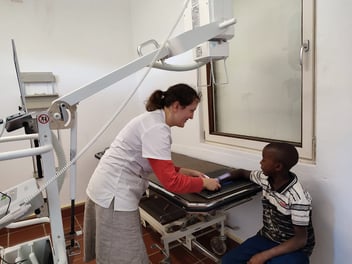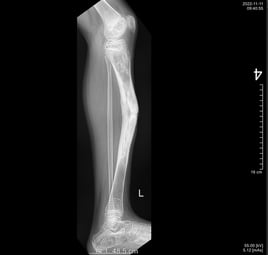Being a radiographer in Mozambique is certainly different from being one in Switzerland. Kerstin Koller, radiographer, talks about her experiences working in Southeast Africa. Mozambique is a beautiful and fascinating country on the south-eastern coast of Africa. It borders Tanzania to the north, South Africa, Zambia and Malawi to the south and west, and the Indian Ocean to the east. Mozambique has a rich and diverse cultural history, with African, Arab and European influences. The Portuguese governed the country during the colonial period, which is reflected in the country's language, architecture and cuisine. Mozambique is also known for its breathtaking nature.
Mozambique is a beautiful and fascinating country on the south-eastern coast of Africa. It borders Tanzania to the north, South Africa, Zambia and Malawi to the south and west, and the Indian Ocean to the east. Mozambique has a rich and diverse cultural history, with African, Arab and European influences. The Portuguese governed the country during the colonial period, which is reflected in the country's language, architecture and cuisine. Mozambique is also known for its breathtaking nature.
Despite its rich natural resources, Mozambique is one of the poorest countries in the world. The majority of the population lives in poverty and struggles to survive on a daily basis. The country is also affected by natural disasters such as floods and droughts, which worsen the country's economic situation.
In this interview, we will discuss some of the challenges Mozambique faces, but also get to know the beauty and culture of the country better.
Kerstin, before you tell us about your adventure, we would like to know why you decided to become a radiographer?
Like many other people out there, I was also not aware that the profession of radiology specialists existed. But thanks to an acquaintance, I went to have a look at the radiology department and immediately fell in love with this job and it has been my vocation ever since.
Now you are living out your vocation in a mission abroad in Mozambique. What motivated you to do this?-jpeg.jpeg?width=289&height=385&name=WhatsApp%20Image%202023-04-18%20at%2011-06-34%20(2)-jpeg.jpeg)
I have always been a person who prefers to do good rather than just make money and this experience here in Mozambique is so fulfilling that no amount of money in the world could pay for it. By chance, I stumbled across the charity Doctors for Life after my studies and saw the development project in Mozambique, whose aim was to improve access to healthcare in underserved areas. But because it didn't have radiology imaging equipment at the time, I couldn't get started straight away.
Three years ago, the organisation contacted me and informed me about the possibility of setting up a radiology department in Mozambique, and so my adventure began.
What were your first impressions of Mozambique?
The population of Mozambique lives very simply and modestly, as there are not many job opportunities in the country. The high humidity coupled with the temperature does not make it easy for people to feed themselves from their own garden. Which is why many go to South Africa to earn a little money.
The "city" in Mozambique is not really a city as we know it in Europe. From the infrastructure, you can't tell from the outside whether it's a house or a shop. If you are new to the city, it is difficult to find your way around.
And what does a hospital look like in Mozambique?
There are not really hospitals in Mozambique as we know it in Europe. Hospitals here are several small houses the size of a sports hall with 4-6 rooms. Each of these houses is comparable to a department in European hospitals. For example, in one house there is only wound care and in the other the ward with 20-30 beds per room.
What were your main tasks as a radiographer on site?
My first task on site was to build a radiology department. For this, I first had to convince the doctors of my construction plan for the radiology department. Then we built an X-ray protection wall out of lead, which was used for classic X-rays. Besides building the radiology department, I also worked a lot in wound care, because there are many people who have abscesses due to poor hygiene.
What type of X-ray machine is in use?
The X-ray machine in use is the DRGem Jade Portable X-ray System. It has a power of 4 kW and a frequency of 100 kHz. The unit can generate a maximum voltage of 140 kVp and a current of 0.1 to 250 mAs. Accordingly, the weak device is not made for all examinations and cannot always reproduce the best images. On the other hand, the portable design of the Jade system allows X-rays to be taken quickly and easily in different locations, making it a practical device for use in medical imaging in Mozambique.
What were the difficulties you experienced there as a radiology specialist?
The first challenge I faced was the sand. There was sand everywhere, which made wound care much more difficult. Besides the sand, the heat and high humidity were not ideal for the X-ray machine. After talking to an X-ray technician from Switzerland, I followed his recommendations and completely sealed the room where the X-ray unit was. A dehumidifier now keeps the humidity at 35-40%.
The power supply is not stable either. But I am often grateful that we don't have to struggle with power cuts for half a day like in South Africa. In this country, the power only goes out when a tree falls down because of the storm or because of termites cutting the line. For such cases, we also have a diesel generator that supplies us with electricity in emergencies.
Were there also difficulties with communication, as the national language of Mozambique is Portuguese?
Although the national language is Portuguese, many, especially the elders and the children in my region speak Chopi, which is completely different from Portuguese. For this reason, I also have interpreters who can communicate in the different languages of Mozambique to help me with instructions, such as breathing commands. Fortunately, in this country, you don't have to build trust with the patients first - they usually listen to my instructions.
Overall, I think the language diversity in Mozambique is challenging, but I am willing to adapt and improve my skills in order to provide the best possible medical care.
What are the classic cases that you examine as a radiographer in Mozambique?
The most common investigations are fractures. I suspect this is due to the lack of nutrition. Because even the slightest stumble is often enough for a microfracture. We rarely do thoracic examinations because I can't really see the fine structures with the X-ray machine. Because of the weak X-ray machine, pelvic and hip axial examinations are also difficult. You can't rule anything out 100% when making a diagnosis.
What device are you missing in Mozambique to take health care to the next level?
Since I work a lot with the X-ray machine here, I would like to have a powerful machine so that I can also take better images and recognize the fine structures. But much more important than a powerful X-ray machine would be a small laboratory. Because too often people just speculate here. With a laboratory, the problem of iron deficiency or any inflammation levels would be recognised immediately and appropriate precautions would be taken. This would also make it easier to take the right steps and find the right medicine.
Besides examinations, wound treatment is also one of your tasks in Mozambique. What are the most impressive experiences you have had there so far?
There are different things you experience here. But what I find most frightening is the fact that people are too relaxed and too calm and don't take many things so seriously. For example, a little girl at work chopped off her finger and it was only hanging on one side of her skin. For her, however, the incident was not a big deal because she only went to the clinic two days later to have the wound treated.
To support you and Doctors for Life, we have sent you some positioning aids. How are they holding up after half a year in high humidity, heat and sand?
The cushions work perfectly and the surface is also still in tact. I use the ProFoam wedges not only for X-rays but also for wound care. Thanks to the ProFoam wedges, I no longer have to improvise when positioning patients and have to resort to waste bins, for example. Wiping off body fluids is also much easier.
With the health facility, you are trying to improve health care in Mozambique. How are you trying to improve people's health in general?
In the meantime, we try to go to the surrounding "communities" and give the residents recommendations for personal hygiene. This is about improving their hygiene in their private daily lives with little things like brushing their teeth daily, using soap and cooking their clothes. The problem is also that they do not prioritise hygiene and health. That's why we also have to teach them that it's better to buy a toothbrush instead of a new dress. I have the feeling that here nobody really knows how long they are going to live and therefore they really only live for the next day.
How did your time in Mozambique influence you personally? -jpeg.jpeg?width=362&height=271&name=WhatsApp%20Image%202023-04-18%20at%2011-06-34%20(1)-jpeg.jpeg)
I have been able to learn a lot about myself. I can now also be more patient and more accommodating to others than before. It is a great lesson in many things. Things I thought were important no longer seem so important. On the whole, there is a lot to learn from Mozambique and Mozambique also has a lot to learn from Europe.
I also hope that one or the other will come to visit me. Because you have no idea what Mozambique is really like until you've been here. On the one hand it is a culture shock and on the other hand it is simply overwhelmingly beautiful.
About Doctors for Life
Doctors For Life International (DFL) is a non-profit organisation founded and established in South Africa in 1991. The long-term goal of Doctors for Life is to establish permanent medical clinics in resource-poor countries in sub-Saharan Africa. Currently, Doctors for Life operates two clinics, one in Mozambique and the other in Malawi http://www.doctorsforlife.co.za
